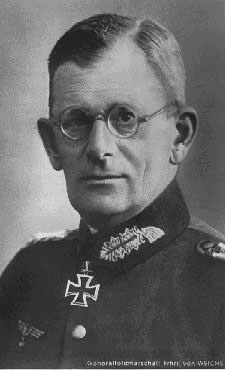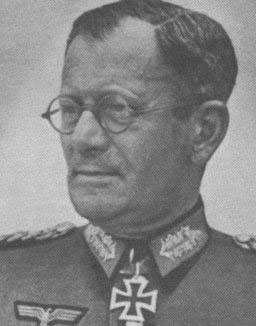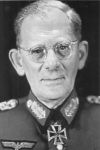Military career
Maximilian Maria Joseph Karl Gabriel Lamoral Reichsfreiherr von und zu Weichs an der Glon was born November 12, 1881 in Dessau in Prussian Saxonia. He was the son of a Prussian cavalry officer. After the early demise of his father, Maximilian and his mother moved to Munich where he graduated from high school.
After having completed his military training, Von Weichs entered service in the Bavarian 2. Schwere Reiter-Regiment on July 15, 1901. Thereafter he was in command of a cavalry school and subsequently joined the Bavarian General Staff. During World War One he served as a liaison officer in the rank of Rittmeister on the staff of the Bavarian Kavallerie-Division and later on as a member of the General Staff. He was involved in various battles, such as those of Lagarde, Lorraine, Champagne, on the Somme and in Flanders.
Definitielijst
- cavalry
- Originally the designation for mounted troops. During World War 2 the term was used for armoured units. Main tasks are reconnaissance, attack and support of infantry.
- Regiment
- Part of a division. A division divided into a number of regiments. In the army traditionally the name of the major organised unit of one type of weapon.
Between the wars
After the war, Von Weichs remained in the seriously depleted officers corps. His career unfolded brilliantly: after having held the position of commander of Kavallerie-Regiment 18, in 1930 he became chief of staff of 1. Kavallerie-Division. In 1933, shortly after Adolf Hitler’s rise to power, he was promoted to Generalmajor and the next year he was placed in command of 3. Kavallerie-Division. In 1935, after the reintroduction of conscription, this division was converted into 1. Panzer-Division. Following this conversion and because of his assistance in the establishment of this new armored unit, he was promoted to Generalleutnant. The next year saw him promoted to General der Kavallerie and in 1937 he was placed in command of XIII. Armeekorps. He was fired by Hitler though because he was a ‘non cooperative’ general. A short time later, he was reinstated as commander of the Korps. The unit took part in the occupation of the Sudetenland in October 1938 and the occupation of Czechoslovakia in the spring of 1939.
Definitielijst
- Regiment
- Part of a division. A division divided into a number of regiments. In the army traditionally the name of the major organised unit of one type of weapon.
Second World War
XIII. Armeekorps was also involved in the capture of Warsaw during Fall Weiß. In October, he became Commander-in-Chief of 2. Armee and took part in the conquest of France during Fall Gelb. After the success of this campaign he was promoted to Generaloberst and was awarded the Ritterkreuz. In 1942, he took part in the campaign on the Balkans with this unit and on April 16, he accepted the capitulation of the Yugoslav army.
During Operation Barbarossa, the invasion of the Soviet Union, Von Weichs’ 2. Armee was part of Heeresgruppe Süd and in that capacity, his army captured Brest-Litovsk and assisted in clearing various large Soviet encirclements. After some problems with his health, he led his 2. Armee through the Russian winter.
In July 1942, during Fall Blau the new summer offensive, Von Weichs was Commander-in-Chief of a temporary group, Armeegruppe Von Weichs, consisting of three armies. He remained C-i-C of 2. Armee with which he managed a modest encirclement on July 2. In mid-July he took over Heeresgruppe B from Generalfeldmarschall Fedor von Bock who had been relieved of his function due to an argument with Hitler. The unit had grown into a formidable force made up of 8 armies. The group struck towards Stalingrad with 6. Armee and 4. Panzerarmee in the lead. Von Weichs ordered these two armies to launch a concentric attack on the Soviets west of the city. Mainly because of the long and weakly defended flanks, the operation failed. In Operation Uranus and Kleine Saturnus, the Soviets broke through the flanks of the Heeresgruppe which were mainly defended by the weaker forces of Germany’s allies. Nearly all troops in Stalingrad, most of them part of the Heeresgruppe, were surrounded and subsequently destroyed. The group was disbanded and the remnants were divided between Heeresgruppe Mitte and Heeresgruppe Süd. Nonetheless, Von Weichs and three other generals who were involved in the battle of Stalingrad, were promoted to Generalfeldmarschall on February 1.
As late as August 1943, Von Weichs was given a new task: he was appointed Oberbefehlshaber Süd-Ost and at the same time OB Heeresgruppe F. In the fall of 1944, he coordinated the orderly evacuation of Greece and Yugoslavia, contrary to Hitler’s orders. He made the OKW believe the planned retreat of his forces was necessary due to enemy counterattacks. As OB of the entire southeastern front, he was also active in the Balkans where he managed to take one-fifth of Tito’s partisans prisoner. When the situation deteriorated, he asked Hitler’s permission to retreat but the latter refused. The Soviets threatened Von Weichs’ rearguard from Romania but he managed to hold the front in a clever way. Early in 1945, the Soviets broke through Von Weichs’ forces in the direction of Austria. Yet, on February 5, 1945 he was awarded the Eichenlaub to his Ritterkreuz. From March 25 onwards, he was placed in reserve and on May 2, 1945 he was arrested in Ettal in Bavaria by American soldiers.
During the South-East trial, Von Weichs was charged with war crimes due to the retaliatory measures in the battles against the partisans. Due to his poor health, he was not sentenced and after 3 years imprisonment, he was released in 1948. After a prolonged sickbed, Maximilian Reichsfreiherr von Weichs died in the family-owned Castle Rösberg near Bonn on September 27, 1954.
Definitielijst
- Armeegruppe
- Usually consisted of two or three neighbouring Armees, sometimes German and Axis-allied Armees. One Armee HQ, usually the German, temporarily became the commanding HQ of the other Armees. An Armeegruppe would always be subject to a Heeresgruppe. Later in the war the size of an Armeegruppe or Panzergruppe varied significantly. From 1943 onwards an Armeegruppe could be the size of an Armee or just the size of a corps.
- capitulation
- Agreement between fighting parties concerning the surrender of a country or an army.
- Heeresgruppe
- The largest German ground formation and was directly subordinate to the OKH. Mainly consisting of a number of “Armeen” with few directly subordinate other units. A Heeresgruppe operated in a large area and could number several 100,000 men.
- mid
- Military intelligence service.
- OKW
- “Oberkommando der Wehrmacht”. German supreme command of the Armed Forces, Army, Air Force and Navy.
- Soviet Union
- Soviet Russia, alternative name for the USSR.
- war crimes
- Crimes committed in wartime. Often concerning crimes committed by soldiers against civilians.
Information
- Article by:
- Auke de Vlieger
- Translated by:
- Arnold Palthe
- Published on:
- 19-01-2025
- Feedback?
- Send it!












